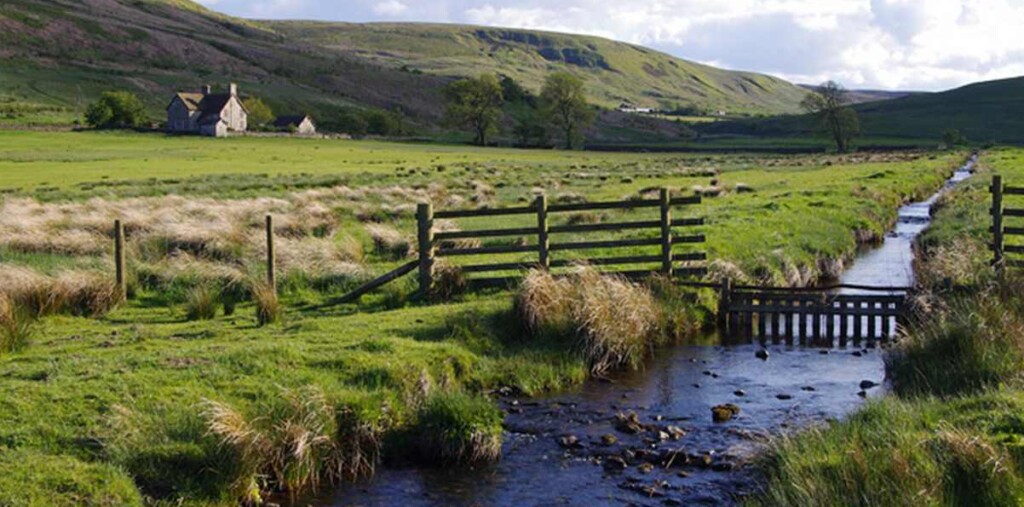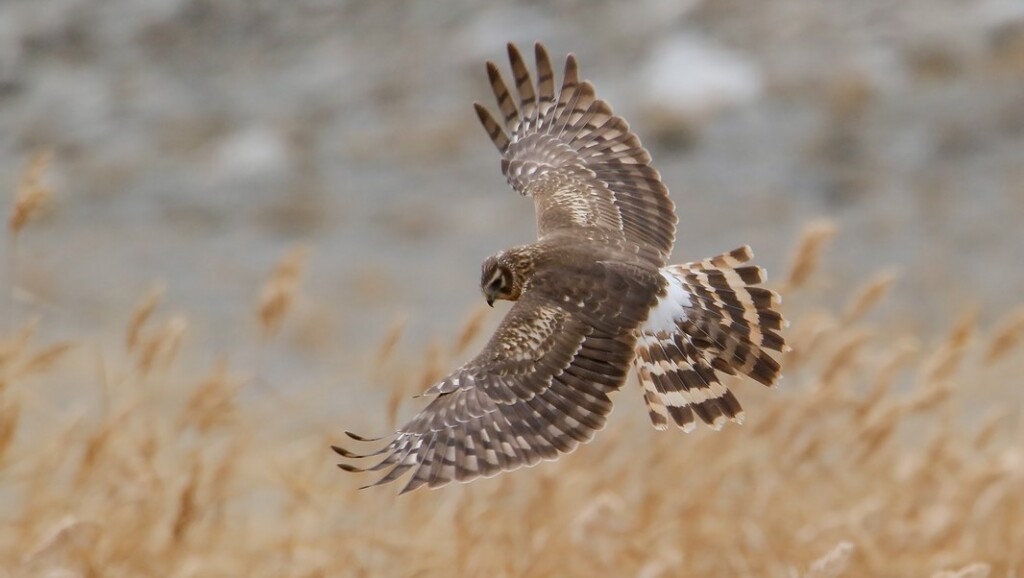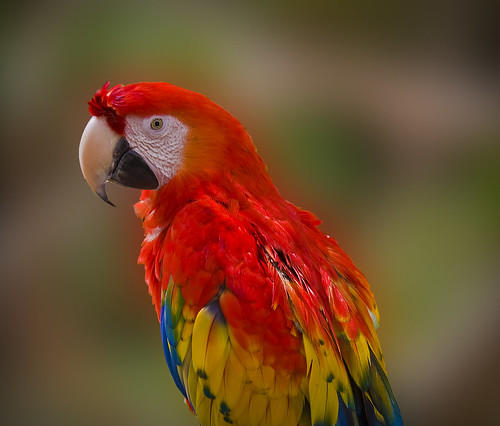
The Wilson's Bird-of-paradise, Cicinnurus respublica, is a small, up to 21 cm long,
passerine bird of the
Paradisaeidae family. The male is a red and black
bird-of-paradise, with a yellow mantle on its neck, light green mouth, rich blue feet and two curved violet tail feathers. The head is naked blue, with black double
cross pattern on it. The female is a brownish bird with bare blue crown. In the field, the blue bare skin on the crown of the bird's head is so vivid that it is clearly visible by night; the deep scarlet back and velvet green breast are lush, the
curlicue tail gleaming bright silver. An
Indonesian endemic, the Wilson's Bird-of-paradise is distributed to the hill and lowland rainforests of
Waigeo and
Batanta Islands off
West Papua. The diet consists mainly of fruits and small insects. The
controversial scientific name of this species was given by
Charles Lucien Bonaparte,
Napoleon's nephew and a
republican idealist, who described the bird from a badly damaged trade specimen purchased by British ornithologist
Edward Wilson. In doing so, he beat
John Cassin, who wanted to name the bird in honor of Wilson, by several months. Thirteen years later, in 1863, the
German zoologist[term zoo studies]
Heinrich Agathon Bernsteindiscovered the home grounds of the Wilson's Bird-of-paradise in
Waigeo Island. Due to ongoing
habitat loss, limited range and exploitation, the Wilson's Bird-of-paradise is evaluated as Near Threatened on the
IUCN Red List of Threatened Species. It is listed on Appendix II of
CITES. The first footage of the Wilson's Bird-of-paradise ever to be filmed was recorded in 1996 by
David Attenborough for the
BBC documentary Attenborough in Paradise. He did so by dropping leaves on the forest floor, which irritated the bird into clearing them away.
Source: Article


The European Bee-eater (Merops apiaster) is a
near passerine bird in the
bee-eater family Meropidae. It breeds in southern Europe and in parts of north Africa and western Asia. It is strongly
migratory, wintering in tropical Africa, India and Sri Lanka. This species occurs as a spring overshoot north of its range, with occasional breeding in northwest Europe. This is a bird which breeds in open country in warmer climates. Just as the name suggests, bee-eaters predominantly eat
insects, especially
bees,
wasps and
hornets which are caught in the air by sorties from an open perch. Before eating its meal, a European Bee-eater removes the sting by repeatedly hitting the insect on a hard surface. It eats some 250 bees daily.[
citation needed]
Lizards and
frogs are also taken.[
citation needed]The most important prey item in their diet are
Hymenoptera, mostly
Apis mellifera; a study in Spain found that these comprise 69.4% to 82% of the European bee-eaters' diet Their impact on bee populations however is small; they eat less than 1% of the worker bees in the area in which they live. A study found that European bee-eaters "convert food to body weight more efficiently if they are fed a mixture of bees and dragonflies than if they eat only bees or only dragonfiles.
Source: Article
The Fiery-throated Hummingbird (Panterpe insignis) is a medium-sized
hummingbird which breeds only in the mountains of
Costa Rica and western
Panama. It is the only member of the genus Panterpe. This is a common to abundant bird of montane forest canopy above 1400 m, and also occurs in scrub at the woodland edges and clearings. This
bird is 11 cm long and weighs 5.7 g. It has a straight black bill and dusky feet. The adult Fiery-throated Hummingbird has shiny green body plumage, a blue tail, and a white spot behind the eye. It often looks dark, but when the light catches it at the right angle, it shows a brilliant blue crown, yellow-bordered bright orange throat, and blue chest patch. The sexes are similar, but young birds have rufous fringes to the head plumage. The call is a high-pitched twittering. The female Fiery-throated Hummingbird is entirely responsible for nest building and incubation. She lays two white eggs in a bulky plant-fibre cup nest 2–4 m high at the end of a descending
bamboo stem or on a rootlet under a bank. Incubation takes 15–19 days, and fledging another 20-26. Very little color from the side. The food of this species is nectar, taken from a variety of small flowers, including
epiphytic Ericaceae and
bromeliads. Like other hummingbirds it also takes small insects as an essential source of protein. Male Fiery-throated Hummingbird defend flowers and scrubs in their feeding territories, and are dominant over most other hummingbirds. They will, however, allow females to share their food resources.
Source: Article

The flamebacks or goldenbacks are large
woodpeckers which are resident breeders in tropical southern Asia. They derive their English names from their golden or crimson backs. However, the two flameback
genera Dinopium and Chrysocolaptes are not particularly close relatives. The former are close to the enigmatic
Meiglyptes and possibly
Hemicircus woodpeckers, and the recently-reclassified
Rufous Woodpecker (Micropternus brachyurus). Chrysocolaptes on the other hand appears to be a rather close relative of
Campephilus, the genus of the famous
Ivory-billed Woodpecker.
Source: Article

The Guinea Turaco (Tauraco persa), also known as the Green Turaco, is a species of
turaco, a group of
near-passerines birds. It is found in forests of
West and
Central Africa, ranging from
Senegal east to
DR Congo and south to northern
Angola. It lays two
eggs in a tree platform
nest. It formerly included the
Livingstone's,
Schalow's,
Knysna,
Black-billed and
Fischer's Turacos as
subspecies. persa buffoni is the only subspecies of the Guinea Turaco without a white line below the eye The Guinea Turaco, often inconspicuous in the treetops, is approximately 43 cm long, including a long tail. The
plumage is largely green and the tail and wings are dark purplish, except for the crimson
primary feathers that are very distinct in flight. In the westernmost
subspecies buffoni, which sometimes is known as the Buffon's Turaco, there is a white line above and in front of the eye and a black line below the eye. In the
nominate subspecies of the central part of its range and zenkeri of the southeastern part there also is a second white line below the black line. Unlike similar turacos with red bills, even adult Guinea Turacos lack a white rear edge to the crest. This species is a common in climax forest with plentiful tall trees. It feeds on fruit and blossoms.
Source: Article

The Golden Pheasant or "Chinese Pheasant", (Chrysolophus pictus) is a
gamebird of the order
Galliformes (gallinaceous birds) and the family
Phasianidae. It is native to forests in mountainous areas of western
China, but feral populations have been established in the
United Kingdom and elsewhere. In England they may be found in
East Anglia in the dense forest landscape of the
Breckland. The adult male is 90–105 cm in length, its tail accounting for two-thirds of the total length. It is unmistakable with its golden
crest and rump and bright red body. The deep orange "cape" can be spread in display, appearing as an alternating black and orange fan that covers all of the face except its bright yellow eye with a pinpoint black pupil. Males have a golden-yellow crest with a hint of red at the tip. The face, throat, chin, and the sides of neck are rusty tan. The wattles and orbital skin are both yellow in colour, and the ruff or cape is light orange. The upper back is green and the rest of the back and rump is golden-yellow. The tertiaries are blue whereas the scapulars are dark red. Other characteristics of the male plumage are the central tail feathers, black spotted with cinnamon, as well as the tip of the tail being a cinnamon buff. The upper tail coverts are the same colour as the central tail feathers. The male also has a scarlet breast, and scarlet and light chestnut flanks and underparts. Lower legs and feet are a dull yellow. The female (hen) is much less showy, with a duller mottled brown
plumage similar to that of the female
Common Pheasant. She is darker and more slender than the hen of that species, with a proportionately longer tail (half her 60–80 cm length). The female's breast and sides are barred buff and blackish brown, and the abdomen is plain buff. She has a buff face and throat. Some abnormal females may later in their lifetime get some male plumage. Lower legs and feet are a dull yellow. Both males and females have yellow legs and yellow bills. Despite the male's showy appearance, these hardy
birds are very difficult to see in their natural
habitat, which is dense, dark young
conifer forests with sparse undergrowth. Consequently, little is known about their behaviour in the wild. They feed on the ground on grain, leaves and
invertebrates, but they roost in trees at night. While they can fly, they prefer to run. If startled, they can suddenly burst upwards at great speed and with a distinctive wing sound. Although they can fly in short bursts, they are quite clumsy in flight and spend most of their time on the ground. Golden Pheasants lay 8-12 eggs at a time and will then incubate these for around 22–23 days. They tend to eat berries, grubs, seeds and other types of
vegetation. The male has a metallic call in the breeding season. The Golden Pheasant is commonly found in zoos and aviaries, but often as impure specimens that have the similar
Lady Amherst's Pheasant in their lineage. There are also different mutations of the Golden Pheasant known from birds in captivity, including the Dark-throated, Yellow, Cinnamon, Salmon, Peach, Splash, Mahogony and Silver. In aviculture, the wild type is referred to as "Red Golden" to differentiate it from these mutations.
Source: Article1,
Article2




















